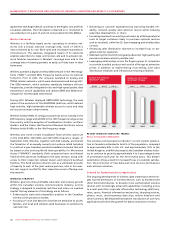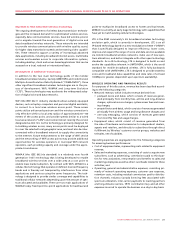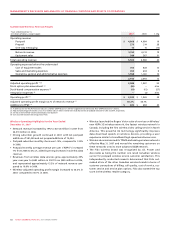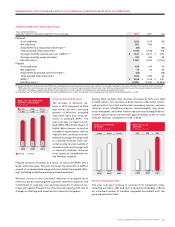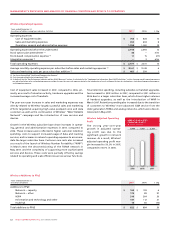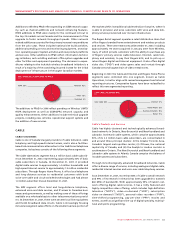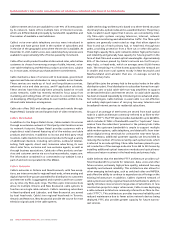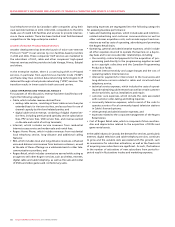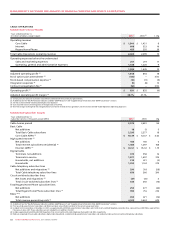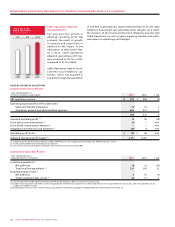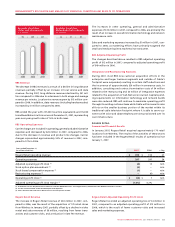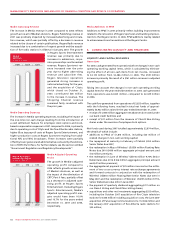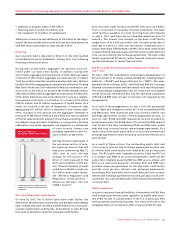Rogers 2007 Annual Report Download - page 39
Download and view the complete annual report
Please find page 39 of the 2007 Rogers annual report below. You can navigate through the pages in the report by either clicking on the pages listed below, or by using the keyword search tool below to find specific information within the annual report.
ROGERS COMMUNICATIONS INC. 2007 ANNUAL REPORT 35
MANAGEMENT’S DISCUSSION AND ANALYSIS OF FINANCIAL CONDITION AND RESULTS OF OPERATIONS
Cable’s voice-over-cable telephony services are offered over an
advanced broadband IP multimedia network layer deployed across
the cable service areas. This network platform provides for a scalable
primary line quality digital voice-over-cable telephony service utiliz-
ing Packet Cable and Data Over Cable Service Interface Specification
(“DOCSIS”) standards, including network redundancy as well as
multi-hour network and customer premises backup powering.
To serve telephony customers on circuit-switched platforms, Cable
co-locates its equipment in the switch centres of the incumbent
local phone companies (“ILECs”). At December 31, 2007, Cable was
active in 179 co-locations in 63 municipalities in five of Canada’s
most populous metropolitan areas in and around Vancouver,
Calgary, Toronto, Ottawa and Montréal. Many of these co-locations
are connected to its local switches by metro area fibre networks
(“MANs”). Cable also operates a North American transcontinental
fibre-optic network extending over 16,000 route kilometres provid-
ing a significant North American geographic footprint connecting
Canada’s largest markets while also reaching key U.S. markets for
the exchange of data and voice traffic. In Canada, the network
extends from Vancouver in the west to Québec City in the east.
Cable also acquired various competitive local exchange carrier
(“CLEC”) assets of Futureway Communications Inc. (“Futureway”) in
the Greater Toronto Area during 2007. The assets include local and
regional fibre, transmission electronics and systems, hubs, points of
presence (“POPs”), ILEC co-locations and switching infrastructure.
Cable’s network extends into the U.S. from Vancouver south to
Seattle in the west, from the Manitoba-Minnesota border, through
Minneapolis, Milwaukee and Chicago in the mid-west and from
Toronto through Buffalo and Montréal through Albany to New York
City in the east. Cable has connected its North American network
with Europe through international gateway switches in New York
City, London, England, and a leased trans-Atlantic fibre facility.
Where Cable doesn’t have its own local facilities directly to a busi-
ness customer’s premises, Cable provides its local services through
a hybrid carrier strategy utilizing unbundled local loops of the
ILECs. Cable has deployed its own scalable switching and intelligent
services infrastructure while using connections between its co-
located equipment and customer premises, provided largely by
other carriers.
CABLE’S STRATEGY
Cable seeks to maximize subscribers, revenue, operating profit,
and return on invested capital by leveraging its technologically
advanced cable network to meet the information, entertainment
and communications needs of its subscribers, from basic cable tele-
vision to advanced two-way cable services, including digital cable,
PPV, VOD, SVOD, PVR and HDTV, Internet access, voice-over-cable
telephony service, as well as the expansion of its services into the
business telecom and data networking market. The key elements
of the strategy are as follows:
• Clusteringofcablesystemsinandaroundmetropolitanareas;
• Offeringawideselectionofproductsandservices;
• Maintainingtechnologicallyadvancedcablenetworks;
• Continuingtofocusonincreasedqualityandreliabilityofser-
vice, and customer satisfaction;
• Tailoring services to the changing demographic of the Cable
customer base, including expansion of products directly serving
several multicultural communities;
• Continuingtoimproveproductfeatures,includingexpanding
available TV content, including HDTV and VOD selection, faster
tiers of Internet service and new telephony service offerings;
• Expandingtheavailabilityofhigh-qualitydigitalprimaryline
voice-over-cable telephony service into most of the markets in its
cable service areas; and
• Furtherexpandingintothebusinessmarketbyfocusingonsmall
businesses connected to the cable network.
RECENT CABLE INDUSTRY TRENDS
Investment in Improved Cable Television Networks and
Expanded Service Offerings
In recent years, North American cable television companies have
made substantial investments in the installation of fibre-optic
cable and electronics in their respective networks and in the devel-
opment of Internet, digital cable and voice-over-cable telephony
services. These investments have enabled cable television compa-
nies to offer expanded packages of digital cable television services,
including VOD and SVOD, pay television packages, PVR, HDTV pro-
gramming, multiple increasingly fast tiers of Internet services, and
telephony services.
Increased Competition from Alternative Broadcasting
Distribution Undertakings
As fully described in the Competition section of this MD&A,
Canadian cable television systems generally face legal and illegal
competition from several alternative multi-channel broadcasting
distribution systems.
Industry Consolidation and Growth of Facilities-Based
Competitors
The Canadian telecommunications industry has seen a consoli-
dation of players in the wireline industry with the acquisitions
in 2004 and 2005 of Group Telecom by Bell Canada, Allstream by
MTS and Call-Net by Rogers. Competition remains intense in the
long-distance markets with average price per minute continuing
to decline year-over-year. Facilities-based competitors in the local
telephone market have emerged in the residential and small and
medium-sized business markets with the launch of competitive
20072006
$3,558$3,201$2,925
CABLE TOTAL
REVENUE
(In millions of dollars)
2006
2007
2005
Pro Forma





